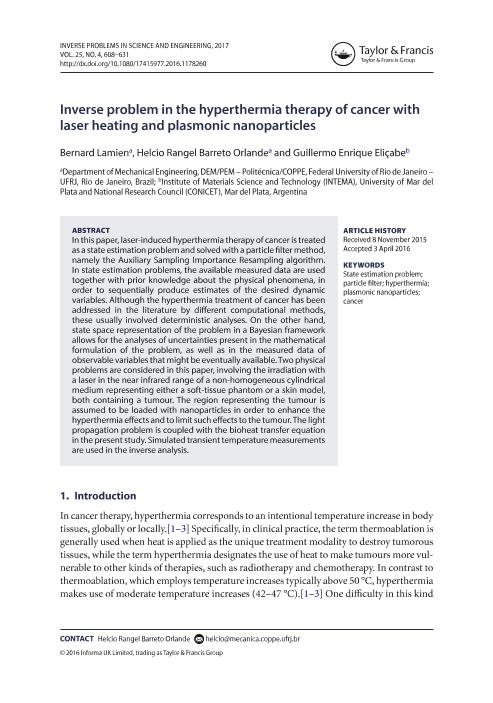Mostrar el registro sencillo del ítem
dc.contributor.author
Lamien, Bernard
dc.contributor.author
Orlande, Helcio Rangel Barreto
dc.contributor.author
Elicabe, Guillermo Enrique

dc.date.available
2017-12-12T16:44:45Z
dc.date.issued
2016-05-16
dc.identifier.citation
Lamien, Bernard; Orlande, Helcio Rangel Barreto; Elicabe, Guillermo Enrique; Inverse problem in the hyperthermia therapy of cancer with laser heating and plasmonic nanoparticles; Taylor & Francis Ltd; Inverse Problems In Science And Engineering; 25; 4; 16-5-2016; 608-631
dc.identifier.issn
1741-5977
dc.identifier.uri
http://hdl.handle.net/11336/30275
dc.description.abstract
In this paper, laser-induced hyperthermia therapy of cancer is treated as a state estimation problem and solved with a particle filter method, namely the Auxiliary Sampling Importance Resampling algorithm. In state estimation problems, the available measured data are used together with prior knowledge about the physical phenomena, in order to sequentially produce estimates of the desired dynamic variables. Although the hyperthermia treatment of cancer has been addressed in the literature by different computational methods, these usually involved deterministic analyses. On the other hand, state space representation of the problem in a Bayesian framework allows for the analyses of uncertainties present in the mathematical formulation of the problem, as well as in the measured data of observable variables that might be eventually available. Two physical problems are considered in this paper, involving the irradiation with a laser in the near infrared range of a non-homogeneous cylindrical medium representing either a soft-tissue phantom or a skin model, both containing a tumour. The region representing the tumour is assumed to be loaded with nanoparticles in order to enhance the hyperthermia effects and to limit such effects to the tumour. The light propagation problem is coupled with the bioheat transfer equation in the present study. Simulated transient temperature measurements are used in the inverse analysis.
dc.format
application/pdf
dc.language.iso
eng
dc.publisher
Taylor & Francis Ltd

dc.rights
info:eu-repo/semantics/openAccess
dc.rights.uri
https://creativecommons.org/licenses/by-nc-sa/2.5/ar/
dc.subject
Cancer
dc.subject
Hyperthermia
dc.subject
Particle Filter
dc.subject
Plasmonic Nanoparticles
dc.subject
State Estimation Problem
dc.subject.classification
Recubrimientos y Películas

dc.subject.classification
Ingeniería de los Materiales

dc.subject.classification
INGENIERÍAS Y TECNOLOGÍAS

dc.title
Inverse problem in the hyperthermia therapy of cancer with laser heating and plasmonic nanoparticles
dc.type
info:eu-repo/semantics/article
dc.type
info:ar-repo/semantics/artículo
dc.type
info:eu-repo/semantics/publishedVersion
dc.date.updated
2017-12-04T18:03:21Z
dc.journal.volume
25
dc.journal.number
4
dc.journal.pagination
608-631
dc.journal.pais
Reino Unido

dc.journal.ciudad
Londres
dc.description.fil
Fil: Lamien, Bernard. Universidade Federal do Rio de Janeiro; Brasil
dc.description.fil
Fil: Orlande, Helcio Rangel Barreto. Universidade Federal do Rio de Janeiro; Brasil
dc.description.fil
Fil: Elicabe, Guillermo Enrique. Consejo Nacional de Investigaciones Científicas y Técnicas. Centro Científico Tecnológico Conicet - Mar del Plata. Instituto de Investigaciones en Ciencia y Tecnología de Materiales. Universidad Nacional de Mar del Plata. Facultad de Ingeniería. Instituto de Investigaciones en Ciencia y Tecnología de Materiales; Argentina
dc.journal.title
Inverse Problems In Science And Engineering

dc.relation.alternativeid
info:eu-repo/semantics/altIdentifier/doi/http://dx.doi.org/10.1080/17415977.2016.1178260
dc.relation.alternativeid
info:eu-repo/semantics/altIdentifier/url/http://www.tandfonline.com/doi/full/10.1080/17415977.2016.1178260
Archivos asociados
